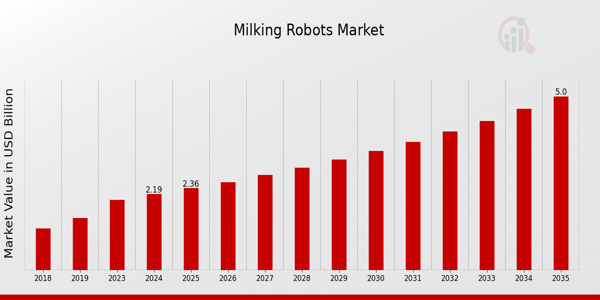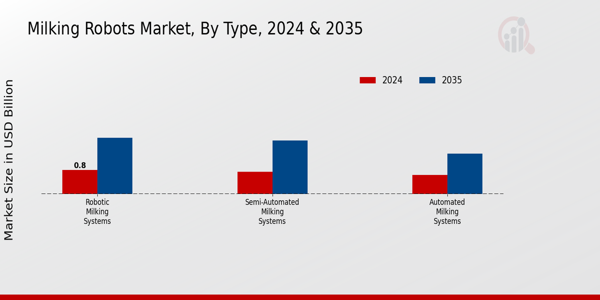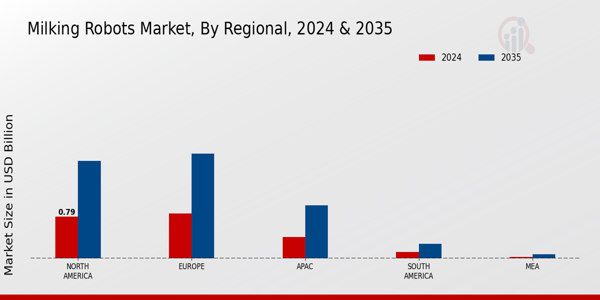Milking Robots Market Summary
As per Market Research Future Analysis, the Milking Robots Market was valued at 2.03 USD Billion in 2023 and is projected to grow to 5.0 USD Billion by 2035, with a CAGR of 7.79% from 2025 to 2035. The market is driven by increasing dairy farm automation, rising demand for high-quality milk, and labor shortages in dairy farming. Key players are investing in advanced technologies to enhance efficiency and productivity in milk production.
Key Market Trends & Highlights
The Milking Robots Market is witnessing significant growth due to various trends.
- Market Size in 2024: USD 2.19 Billion; projected to reach USD 5.0 Billion by 2035.
- Robotic Milking Systems valued at USD 0.8 Billion in 2024; expected to grow to USD 1.87 Billion by 2035.
- Labor shortages reported by over 80% of dairy farms, driving automation adoption.
- Global milk consumption projected to grow by approximately 3% per year, reaching 1,067 million tons by 2025.
Market Size & Forecast
2023 Market Size: USD 2.03 Billion
2024 Market Size: USD 2.19 Billion
2035 Market Size: USD 5.0 Billion
CAGR (2025-2035): 7.79%
Largest Regional Market Share in 2024: North America.
Major Players
Key players include GEA Group, Sacoma, DeLaval, Lely, and BouMatic.
Key Milking Robots Market Trends Highlighted
A number of important market factors are propelling the notable expansion of the Milking Robots Market. Farmers looking for economical and effective ways to increase milk output are a major factor driving the growing demand for automated dairy farming solutions.
An increasing dependence on technology to maintain production and ensure animal care has resulted from workforce constraints in several locations. In order to address the problems of growing output while maintaining quality standards, farmers are resorting to milking robots as the world's dairy demand climbs. As technology continues to change the sector, there are opportunities.
Milking robots are using innovations like artificial intelligence, machine learning, and data analytics to improve herd management, provide real-time monitoring, and perform predictive maintenance. Farmers are increasingly willing to embrace these contemporary solutions as they grow more tech-savvy, which offers manufacturers a great opportunity to investigate.
Furthermore, eco-friendly milking methods are being promoted by sustainability programs, which establish milking robots as an essential part of environmentally conscious dairy production. According to recent developments, there is a growing emphasis on the customization and adaptability of milking robots to accommodate a variety of farming activities.
Because agricultural methods and animal requirements vary by location, producers are modifying their goods to better suit regional needs and tastes. Additionally, collaborations between technology companies and dairy farmers are growing, which promotes information exchange and strengthens the incorporation of milking robots into conventional agricultural practices.
All things considered, the global trend toward automated dairy solutions represents a revolutionary change in the methods and practices around milk production.

Source: Primary Research, Secondary Research, MRFR Database and Analyst Review
Milking Robots Market Drivers
Increasing Demand for Dairy Products
The rising global population has led to an increased demand for dairy products, which is a primary driver for the Milking Robots Market. According to the Food and Agriculture Organization, global milk production is expected to increase by approximately 25% by 2030 to meet this growing demand.
This significant rise necessitates more efficient milking operations, prompting dairy farmers to invest in milking robots. Companies like DeLaval and Lely are leading this trend, with their advanced milking technologies enabling farms to enhance productivity and milk quality.
Moreover, as dairy farms aim to produce more milk with the same or fewer resources due to rising operational costs and environmental regulations, milking robots become an attractive solution, streamlining the milking process and ensuring increased efficiency.
The consistent need to meet dairy product consumption goals worldwide highlights the critical role of milking robots in modern dairy farming.
Technological Advancements in Milking Robots
Continuous innovations in robotics and automation technology are significantly driving the Milking Robots Market. Recent advancements, such as Artificial Intelligence and Machine Learning, have enhanced the efficiency and reliability of milking robots.
According to reports, the integration of these technologies has increased the precision of milking operations by up to 30%, ensuring higher quality milk output and optimizing labor usage on farms. Major industry players like GEA Group and RoboMilk are focusing on Research and Development (R&D) to innovate more sophisticated milking solutions.
The European Union’s support for technological advancements in agriculture is also nurturing a favorable environment for milking robots, thus encouraging dairy farmers to adopt such equipment to stay competitive.
Labor Shortages in the Agricultural Sector
The agricultural sector is facing a significant labor shortage, which acts as a strong driver for the Milking Robots Market. A recent report from the United States Department of Agriculture indicated that farms have reported a 20% reduction in available labor over the past decade, making it increasingly challenging to maintain traditional milking practices.
This shortage pushes farm owners towards automation solutions like milking robots, which can operate independently and reduce the dependence on human labor.
Companies such as BouMatic and Lely are addressing this need by providing reliable robotic solutions that not only mitigate labor deficits but also improve efficiency at milking operations. As a result, the trend towards automation is becoming essential for the sustainability of dairy farms globally.
Government Initiatives Supporting Automation in Agriculture
Various government initiatives focused on promoting automation in agriculture are positively influencing the Milking Robots Market. For instance, the recent agricultural reforms in countries across the European Union aim to promote smart farming solutions, with increased funding allocated for technological adoption.
An estimated €1 billion has been set aside for the modernization of agricultural sectors, which includes the use of milking robots. These initiatives are expected to enhance farm productivity and sustainability, encouraging more dairy farmers to transition towards automated milking systems.
Industry leaders such as AG Leader Technology are capitalizing on this governmental support, ensuring that milking robots are a feasible and beneficial option for farmers looking to invest in modern technologies.
Milking Robots Market Segment Insights:
Milking Robots Market Application Insights
The Milking Robots Market segmentation presented significant insights specifically within the Application segment, which comprised critical areas such as Dairy Farms, Research Institutions, and Agricultural Cooperatives.
In 2024, the Dairy Farms Application was valued at 1.3 USD billion, representing the majority holding in this market sector and showcasing its substantial role in the automation of milking processes, which enhances productivity and efficiency for farmers.
By 2035, the valuation for Dairy Farms is projected to reach 3.0 USD billion, underscoring a robust growth trajectory fueled by advancements in technology that improve animal welfare and streamline operations.
Research institutions, another vital component of the Milking Robots Market data, showed a valuation of 0.55 USD billion in 2024, expected to rise to 1.2 USD billion by 2035. This growth reflected a significant opportunity for innovation and the development of new robotic technologies aimed at improving dairy farming practices, indicating their essential role in supporting the agricultural sector through research and development.
Meanwhile, Agricultural Cooperatives, while the smallest segment, held an important position in the market, starting at 0.34 USD billion in 2024 and increasing to 0.8 USD billion by 2035, indicating the collaborative approach of farmers to invest in milking robots to optimize milk production collectively.
The collaborative strategies among these cooperatives help them to adopt advanced milking technologies, thereby improving efficiency and reducing operational costs.
Overall, these Application-centric insights highlighted how each area contributes to the evolving landscape of the Milking Robots Market, driving growth through technological advancements and changing practices in the dairy industry.

Source: Primary Research, Secondary Research, MRFR Database and Analyst Review
Milking Robots Market Type Insights
The Milking Robots Market is segmented by Type into Robotic Milking Systems, Semi-Automated Milking Systems, and Automated Milking Systems, each playing a crucial role in modern dairy farming practices.
Robotic Milking Systems are becoming increasingly popular due to their efficiency and ability to enhance milk yield, allowing farmers to manage herds more effectively. Similarly, Semi-Automated and Automated Milking Systems are significant contributors, automating routine tasks that previously required labor-intensive approaches.
This trend is vital as it not only optimizes production but also addresses labor shortages in rural areas. Overall, the Milking Robots Market demonstrates a robust growth trajectory driven by technological advancements, rising consumer demand for dairy products, and the need for improved animal welfare.
These systems offer substantial opportunities for farmers to enhance productivity while adapting to sustainable farming practices. The underlying statistics highlight a steady growth pattern, aligning with emerging trends in agricultural automation, which further bolsters the market's appeal.
Milking Robots Market Technology Insights
The market segmentation highlights essential components such as Computerized Control Systems, Sensors and Monitoring Devices, and Data Analytics Software. Computerized Control Systems play a pivotal role in automating milking processes, enhancing efficiency, and minimizing manual labor.
Sensors and Monitoring Devices are crucial for real-time tracking of herd health and milk quality, ensuring that farmers can make informed decisions. Data Analytics Software becomes significant as it enables dairy farmers to leverage data insights for optimizing production and managing resources effectively.
This technological advancement is driven by the increasing demand for automation in dairy farming and the need for improved operational efficiency, while challenges such as high initial costs can impact market entry for some players.
The Milking Robots Market statistics highlight a growing trend towards smart technology adoption, providing ample opportunities for innovation and growth in this sector.
Milking Robots Market Farm Size Insights
The Milking Robots Market focuses significantly on the Farm Size segment, recognizing the distinct needs across different operational scales.
The segmentation of this market into Small Scale Farms, Medium Scale Farms, and Large Scale Farms highlights diverse opportunities and challenges inherent to each category. Small-scale farms often adopt milking robots to enhance efficiency and reduce labor costs, supporting sustainable practices.
Medium-scale farms leverage these technologies to optimize production and maintain a competitive advantage within the industry. In contrast, large-scale farms are likely to dominate, driving major investments and technological advancements due to their extensive production capacities.
This segment showcases significant growth potential, given the increasing demand for milk production worldwide and the subsequent integration of automation. As dairy operations continue to evolve, the Milking Robots Market data emphasizes the necessity for tailored solutions that cater to the specific requirements of each farm size, enabling better productivity and efficiency across the globe.
Milking Robots Market Regional Insights
The Milking Robots Market revenue exhibited distinct variations across its regional segments. In 2024, North America held a significant valuation of 0.584 USD billion, reflecting its dominance due to advanced dairy farming technologies and high adoption rates of automation.
Europe closely followed with a valuation of 0.755 USD billion in the same year, driven by stringent dairy regulations and a strong focus on efficiency. The Asia Pacific region, valued at 0.481 USD billion in 2024, is rapidly catching up as countries like China and India invest in modern dairy practices, showing potential for growth.
Meanwhile, South America, valued at 0.137 USD billion, and the Middle East and Africa, with a valuation of 0.233 USD billion, represented emerging markets where improvements in dairy production are slowly gaining momentum. The market growth in these regions is fueled by the increasing demand for milk and dairy products, coupled with technological advancements in automation.
However, challenges such as high initial costs and maintenance of milking robots remained relevant. Overall, the Milking Robots Market statistics indicate a segmented yet flourishing industry, with varying opportunities and advancements across regions.

Source: Primary Research, Secondary Research, MRFR Database and Analyst Review
Milking Robots Market Key Players and Competitive Insights:
The Milking Robots Market is characterized by an increasing demand for automated milking solutions driven by the need for enhanced efficiency and productivity in the dairy industry. This market is marked by technological innovations, with manufacturers focusing on developing advanced robotic systems that optimize the milking process while ensuring the well-being of the animals.
The competitive landscape is increasingly influenced by factors such as the adoption of precision farming techniques and the growing emphasis on sustainable farming practices. Companies are striving to secure their market positions by investing in research and development to create more efficient and user-friendly robotic milking systems.
The landscape also shows notable trends toward the integration of IoT and AI in milking solutions, further driving competition among key players.
Inventive Solutions has established a significant presence within the Milking Robots Market, focusing on delivering cutting-edge technology tailored to meet the specific needs of dairy farmers. The company's strengths lie in its commitment to innovation and quality, providing reliable solutions that enhance the efficiency of milking operations.
By emphasizing customer engagement and service, Inventive Solutions has cultivated a strong reputation, which plays a crucial role in distinguishing itself amid competitors. The company has also developed a range of user-friendly interfaces and robust support systems, allowing users to easily integrate these advanced technologies into their farming operations.
This focus on customer satisfaction and operational excellence has positioned Inventive Solutions favorably within the expanding global market for milking robots.
RoboMilk is another prominent player in the Milking Robots Market, recognized for its range of high-performance robotic milking systems. The company offers innovative products designed to streamline the milking process, improve animal welfare, and maximize farm productivity.
RoboMilk's strengths stem from its robust technological foundations and its ability to adapt to the evolving needs of dairy farmers worldwide. The firm actively engages in strategic mergers and acquisitions to bolster its market presence and expand its product offerings, enabling it to keep pace with competitors and respond to consumer demands effectively.
Additionally, RoboMilk's commitment to sustainability and environmental stewardship resonates well with the current market dynamics, positioning it as a leader in the sector. This dedication, in combination with its advanced technological capabilities, showcases RoboMilk's strength in delivering comprehensive solutions to the global dairy industry.
Key Companies in the Milking Robots Market Include:
-
Inventive Solutions
-
RoboMilk
-
DairyMaster
-
Schaefer Ventilation
-
Lely
-
DeLaval
-
VMS Systems
-
GEA Group
-
Afimilk
-
WestfaliaSurge
-
MooMonitor
-
BouMatic
-
Milkomax
-
Zuuid Dairy Robotics
-
Trioliet
Milking Robots Market Developments
-
Q2 2024: Lely launches new Astronaut A5 NextGen milking robot Lely announced the launch of its Astronaut A5 NextGen milking robot, featuring enhanced automation and data integration capabilities to improve dairy farm efficiency and animal welfare.
-
Q2 2024: GEA presents DairyRobot R9500 with new hygiene features at EuroTier 2024 GEA Group unveiled an upgraded version of its DairyRobot R9500 at EuroTier 2024, introducing advanced hygiene modules and improved user interface for automated milking systems.
-
Q3 2024: BouMatic opens new robotic milking technology center in Wisconsin BouMatic inaugurated a new technology center in Wisconsin dedicated to research, development, and demonstration of its latest robotic milking solutions.
-
Q3 2024: DeLaval appoints new CEO to drive innovation in automated milking DeLaval announced the appointment of a new CEO, emphasizing a strategic focus on expanding its automated milking product line and global market presence.
-
Q4 2024: Lely and Microsoft announce partnership to develop AI-powered dairy farm solutions Lely and Microsoft entered a partnership to integrate artificial intelligence and cloud analytics into Lely's milking robots, aiming to optimize herd management and productivity.
-
Q4 2024: GEA Group acquires minority stake in Dutch milking robot startup Connecterra GEA Group acquired a minority stake in Connecterra, a Dutch startup specializing in AI-driven dairy farm automation, to strengthen its position in the robotic milking sector.
-
Q1 2025: DeLaval launches VMS V310 with integrated mastitis detection DeLaval introduced the VMS V310 milking robot, featuring real-time mastitis detection and automated herd health monitoring to improve milk quality and animal care.
-
Q1 2025: Milking robot startup EIO Robotics raises $25M Series B to expand in North America EIO Robotics secured $25 million in Series B funding to accelerate the deployment of its robotic milking systems across North American dairy farms.
-
Q2 2025: Lely opens new manufacturing facility for milking robots in Germany Lely opened a new manufacturing plant in Germany to increase production capacity for its automated milking robots, targeting growing demand in Europe.
-
Q2 2025: GEA secures major contract to supply robotic milking systems to French dairy cooperative GEA Group announced a contract win to deliver its DairyRobot R9500 systems to a leading French dairy cooperative, marking one of the largest single orders in the company's history.
-
Q3 2025: Lely files for IPO on Euronext Amsterdam to fund global expansion Lely filed for an initial public offering on Euronext Amsterdam, aiming to raise capital for international expansion and further development of its robotic milking technologies.
-
Q3 2025: DeLaval partners with John Deere to integrate farm management platforms DeLaval and John Deere announced a partnership to connect their respective farm management software, enabling seamless data flow between milking robots and agricultural machinery.
Milking Robots Market Segmentation Insights
-
Milking Robots Market Application Outlook
-
Milking Robots Market Type Outlook
-
Milking Robots Market Technology Outlook
-
Milking Robots Market Farm Size Outlook
-
Small-Scale Farms
-
Medium-Scale Farms
-
Large-Scale Farms
-
Milking Robots Market Regional Outlook
-
North America
-
Europe
-
South America
-
Asia Pacific
-
Middle East and Africa
|
Report Attribute/Metric
|
Details
|
|
Market Size 2023
|
2.03(USD billion)
|
|
Market Size 2024
|
2.19(USD billion)
|
|
Market Size 2035
|
5.0(USD billion)
|
|
Compound Annual Growth Rate (CAGR)
|
7.79% (2025 - 2035)
|
|
Report Coverage
|
Revenue Forecast, Competitive Landscape, Growth Factors, and Trends
|
|
Base Year
|
2024
|
|
Market Forecast Period
|
2025 - 2035
|
|
Historical Data
|
2019 - 2024
|
|
Market Forecast Units
|
USD billion
|
|
Key Companies Profiled
|
Inventive Solutions, RoboMilk, DairyMaster, Schaefer Ventilation, Lely, DeLaval, VMS Systems, GEA Group, Afimilk, WestfaliaSurge, MooMonitor, BouMatic, Milkomax, Zuuid Dairy Robotics, Trioliet
|
|
Segments Covered
|
Application, Type, Technology, Farm Size, Regional
|
|
Key Market Opportunities
|
Increased dairy farm automation, Rising demand for dairy products, Technological advancements in robotics, Expansion in emerging markets, Government incentives for modern farming
|
|
Key Market Dynamics
|
increased labor costs, technological advancements, rising dairy consumption, focus on animal welfare, government support and subsidies
|
|
Countries Covered
|
North America, Europe, APAC, South America, MEA
|
Frequently Asked Questions (FAQ):
The Milking Robots Market was valued at 2.19 billion USD in the year 2024.
By 2035, the Milking Robots Market is projected to reach a value of 5.0 billion USD.
The market is expected to grow at a CAGR of 7.79% from 2025 to 2035.
In 2024, North America held the largest market share, valued at 0.584 billion USD.
The market size for Dairy Farms is expected to reach 3.0 billion USD by 2035.
Major players in the market include Lely, DeLaval, GEA Group, and DairyMaster, among others.
The market for Research Institutions is anticipated to reach 1.2 billion USD by 2035.
By 2035, the Asia Pacific region is expected to be valued at 1.133 billion USD.
In 2024, the Milking Robots Market for Agricultural Cooperatives was valued at 0.34 billion USD.
The market size for the Middle East and Africa region is projected to be 0.533 billion USD by 2035.

















